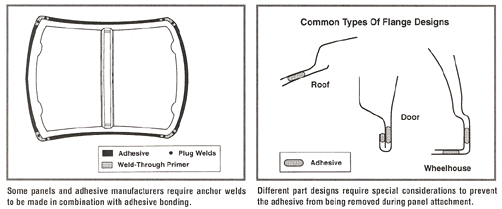Adhesive bonding is becoming more prevalent as more car manufacturers use it in the assembly of their automobiles. It makes sense, then, that more and more adhesive producers are arriving on the scene – filling the marketplace with salespeople and advertising that attest to the wondrous abilities of adhesive bonding.
But is this repair procedure right for a particular job in your shop? A complete understanding of both the automobile and adhesive manufacturers’ recommendations will help you make the right decision.
Don’t Let History Repeat Itself
I was around in 1963 when plastic filler was just beginning to penetrate the collision repair market. This was truly a revolutionary product. Never mind that it was intended to be used only 1/8-inch thick. Immediately, the use of plastic filler went from the sublime (1/9 inch) to the ridiculous (1/2 inch and even thicker). Butchery and hackery were everywhere, and many car owners became “curbstoners.” And the image of our industry suffered from this abuse of a revolutionary product.
Make no mistake. I’m not advocating that we stop using plastic filler. I’m just pointing out, from a historical perspective, that the misuse of some products can damage our industry’s image. When used properly, plastic filler is a legitimate and useful product – but, oh how that filler has been abused.
Alas, I perceive we may be on the threshold of a similar historical event. We – technicians, owners and adhesive product representatives – must work together to assure that adhesive bonding is done only in a prescribed manner, as recommended by the vehicle’s manufacturer and the producer of the adhesive bonding material.
Just as the abusers of lead filling became abusers of plastic filler filling, so will lousy welders be poor adhesive bonders. Adhesive bonding is an exact process that requires adherence to specific, explicit instructions.
Can a good fit and finish be obtained using a bad process and by shortcutting recommended procedures? Absolutely. Is the potential for subsequent bond failure imminent and the crashworthiness of the improperly bonded part seriously compromised? Absolutely. Can you or the customer see that the part is improperly bonded prior to failure? Probably not. Is the potential present for abuse? Absolutely.
Already, horror stories are beginning to surface. I heard one last week from a shop that repaired a front-end collision in which a radiator core support had been bonded in a previous repair. Yes, I said bonded, not welded! The technician literally ripped the support off with his hands. I’m not blaming the adhesive producer or their product for this. It was never a recommended use. The same thing could’ve happened with poor welding – but the failure probably wouldn’t have been quite as impressive.
What I’m trying to emphasize here is that adhesive bonding is only a legitimate process when the automobile manufacturer recommends it as a process to use when replacing a part and when it’s done in accordance with the adhesive producer’s recommendations.
Know the Recommended Procedures
We’ve seen door skins bonded by auto manufacturers for several years. Does this mean they all recommend that we, as repair technicians, use adhesive bonding in the replacement of a door skin during the collision repair process? No. Some manufacturers say yes; some say no. Why? I asked one of the naysayers, “If you use adhesive bonding to install a door skin, why can’t the collision repair industry?” The answer: “We don’t know what product you’re using or under what conditions you’re using that product. Therefore, we don’t have a recommendation for that process.”
The manufacturers who do recommend bonding do so assuming the use of the adhesive will be consistent with its manufacturer’s recommendations. So be sure to check those recommendation for replacement.
You may also want to consider other industry standards. I-CAR states in writing: “If an exterior body panel is being attached using adhesive bonding:
- The insurer and the customer need to be informed. Repairs must be performed as agreed upon and as described on the repair order.
- Any effect on vehicle warranties should be disclosed.
- The repairer and insurer must be aware of any possible liability exposure.”
The adhesive manufacturer’s recommendations are of the utmost importance. Why? Because they differ from one manufacturer to another. For example: - Some manufacturers want you to remove all existing primer and old adhesive on the mating flanges of the vehicle and the new part, down to the bare metal, in preparation for application of the new adhesive.
- Some manufacturers want you to remove all paint to bare metal and prime mating flanges with two-part epoxy or acid-etch primer.
- Some adhesive manufacturers don’t recommend acid-etch primer under their adhesives.
- Some manufacturers want you to leave a base of the pre-existing adhesive as a foundation for the new adhesive to be applied to.

Get the idea? These adhesives are specifically engineered and designed to be used in a specific method. To do otherwise will compromise their abilities, so follow the instructions. For adhesives that require bare metal mating flanges, it’s imperative that all the bare metal be completely covered with adhesive. Rusting metal due to poorly applied adhesive will seriously compromise the bond.
One technique to prevent this is to lay out a thin bead of adhesive on the mating flange and spread it evenly over all the bare metal with a dauber or acid brush. When the bare metal is completely covered with a thin layer of adhesive, apply a thicker bonding bead to the entire mating flange.
A similar process should be used when working with a flange that has a recommended layer of pre-existing adhesive left on it. Any bare metal abrasions caused by the damaged-panel removal process (usually a reciprocating windshield knife) should be touched up with a two-part epoxy primer on the bare metal only.
Why Weld Bonding?
Automobile manufacturers use a process that employs both spot welding and adhesive bonding. Unfortunately, it’s difficult to duplicate this process in the repair facility, so plug welds are employed in conjunction with weld-through primer and adhesive. Don’t use weld-through primer in the bond zone because it will drastically compromise bonding ability. Masking will be necessary to prevent pollution of the bond zone with weld-through primer.
Weld bonding provides a strong and rattle/squeak-free part replacement. The additional holding power of the well-placed welds and the adhesive bond layer isolating the mating flanges from one another (by just enough adhesive to prevent them from rubbing and flexing against each other) has to be one of the best repair/replacement methods possible – when recommended by the vehicle manufacturer.
Make an Informed Decision
To learn all the pros and cons of bonding, I suggest taking I-CAR’s Adhesive Bonding program. Success can be had by always following the automobile manufacturer’s recommended procedures as well as diligently adhering to all of the adhesive producer’s procedures.
The automobile industry is changing rapidly. As those changes take place, new techniques and procedures for repairing collision-damaged vehicles will be introduced. Like plastic filler in the 1960s, bonding adhesives can help improve the repair process, if they’re used correctly. Just because the technology exists doesn’t mean it’s right for the job at hand. Understand the recommended procedures for when and how to use adhesives, and you’ll ensure strong bonds that stand the test of time.
Writer Mike West, a contributing editor to BodyShop Business, has been a shop owner for almost 30 years and a technician for almost 40 years. His shop in Seattle, Wash., has attained the I-CAR Gold Class distinction and the ASE Blue Seal of Excellence.
The photo and illustrations used in this article originally appeared on the I-CAR Adhesive Bonding Program 1 CD.
Eliminating Shrink Lines
Using adhesives on exposed joints on the exterior of the body (the sail panel or dogleg on a quarter panel, for example) may cause shrink lines, which appear as pronounced lines in the paint. Some people recommend using a plastic filler with reinforced fibers in these areas. I recommend welding in these areas to prevent any shrink lines from appearing.
|
Adhesives 101 1. Acrylic. These types of adhesives are designed to have a high shear strength, high impact resistance and a durable bond. They all require specific procedures for preparation of the mating flanges. There are two types of adhesive bonds: adhesion and cohesion.
With both types of bonds, it’s very important not to over-clamp two mating flanges together. This overly tight joint actually forces too much of the adhesive out of the joint, which causes a weak bond. Some adhesives actually contain glass beads that prevent the overclamping of mating flanges and thus maintain the appropriate adhesive thickness to provide the optimum bond joint. Temperature is also significant when adhesive bonding. Technicians should work between 65 and 95 degrees F. When working in the lower range, cure time and wet time will be extended. Conversely, when working on the high end, cure and wet times will be shortened. |
Don’t Mix Mixing Nozzles
Different two-part adhesives come with different lengths of mixing nozzles that may be interchangeable with other adhesives. However, these nozzles aren’t to be intermixed among different adhesives, even if they fit the cartridge. These nozzles are engineered to mix the adhesive precisely, and changing the nozzle to a different length is a prescription for failure.













